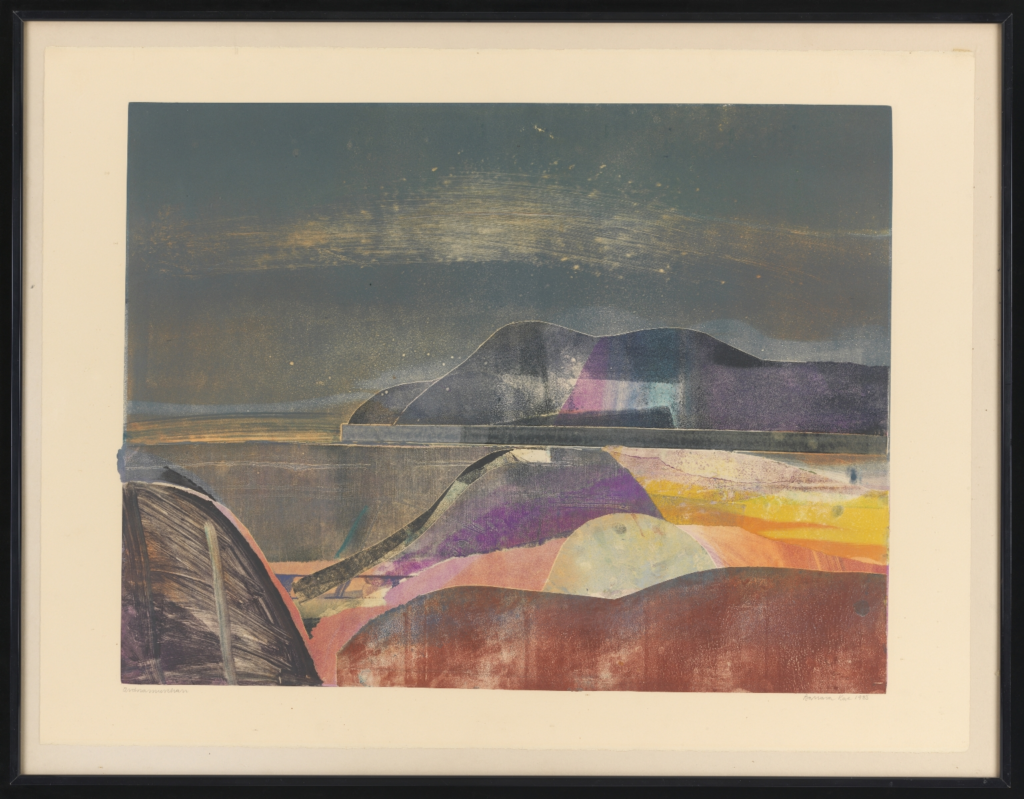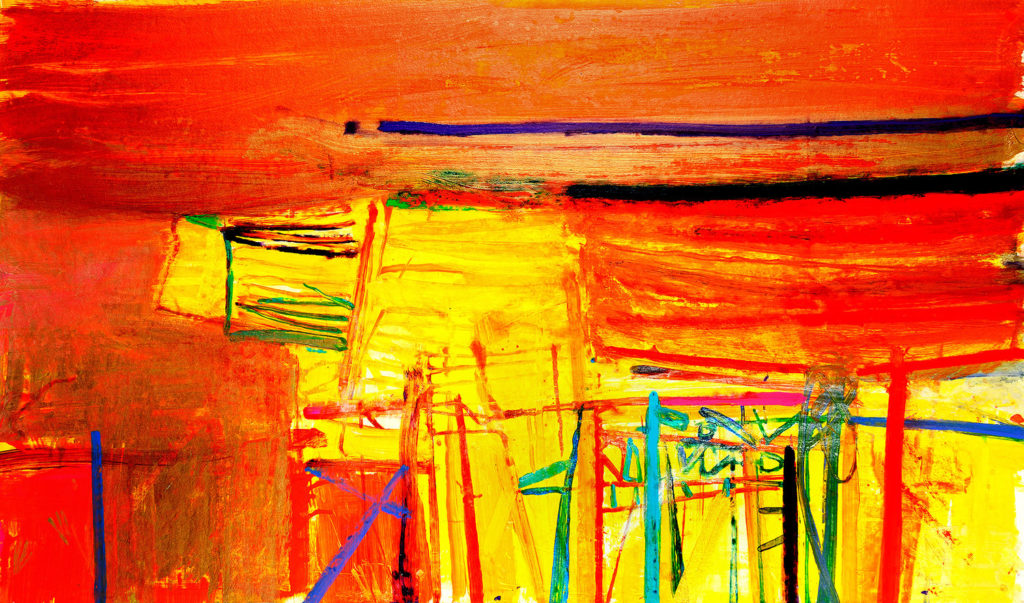This week, we are starting to draft our interpretive text. We have decided that we will present this text as a short leaflet divided into three sections, each corresponding to our exhibition subtitle: “Place,” “Art,” and “Collection.” I have been working on writing the “Place” section, and I am completing background research into how the theme of “place” has been conceptualized in relation to visual art.
For this thematic analysis, I’m exploring a topic peripheral to our exhibition development: how art presents place outside of the landscape genre. Taking my inspiration from one of the works selected for Situated—Barbara Rae’s Ardnamurchan—I ask: How does Barbara Rae situate “place” as central to her artistic practice and artworks, while working outside of the conventions of the landscape genre?

The essays in The Place of Landscape: Concepts, Context, Studies are particularly helpful in developing an analysis of place in art. In the first essay, “Place and the Problem of Landscape,” editor Jeff Malpas theorizes the close relationship between landscape and place. He considers how landscape art is “the view of a view”—not just a rendering of the artist’s visual viewpoint, but also a representation of the artist’s engagement with that view.[1] Malpas suggests that the term “place” encompasses the more-than-visual in landscape art, as it suggests the time and space of the artist’s engagement as well as its visual dimensions. For Malpas, then, landscape art “is the re-presentation of a relatedness to place,” opening up a dynamic he refers to as “emplacement.”[2]
In “Landscapes as Temporalspatial Phenomena,” Theodore R. Schatzki echoes Malpas’s understanding of the time and space of place in art, writing that landscapes are “[temporalspatial phenomena] by virtue of anchoring and being drawn into something I call the timespace of human activity.”[3] Schatzki’s notion of the “timespace of human activity” can be extended beyond landscapes to art about place more generally.
Malpas’s and Schatzki’s understanding of a temporalspatial dimension to art provides an intriguing theoretical backdrop from which to consider Barbara Rae’s artistic practice. Rae’s work is inspired by locations—often those in Scotland, or ones she encounters while travelling—and her website states that “in subject matter Rae’s studies are of a socio-political nature, traces of human existence and artefacts weathered by time and fortune. She records time passing.”[4] Although her works are about places and landscapes, the statement continues: “She is not interested in topography. Though pattern and structure in the background can be a dividend enriching the composition it’s just as often ignored as incorporated in the image. Her point of departure is the history of a place and its people…. She distills the presence of mankind.”[5]
I am particularly compelled by this description of her work “distill[ing] the presence of mankind” given how few of her works include human figures. In this regard, the theoretical framework of “the timespace of human activity” resonates with Rae’s work and can provide a model for it. In Aberdeen Harbour (Scotland), for example, the “timespace of human activity” can be read through Rae’s quick, slapped brushstrokes, which convey a sense of the motion and dynamism of a working harbour. The multi-coloured hulls of the ships appear worn from years of use.

Indeed, Rae’s use of bright colours and her vivid, visible brushstrokes invoke the “timespace” of another human activity—that of her own act of painting. In an echo of Malpas’s description of the more-than-visual dimension of place in art being the time and space of the artist’s engagement with that place, Rae’s engagement with the places she paints is apparent and contributes to their depth and vividness. The low vantage point, cool colours, and bold, straight lines of Island Landing suggest the cold, inhospitable-to-humans setting of a cold-water ocean. By contrast, the higher perspective, warm colours, and organic lines of Roadside – Lanjaron convey a different physical and mental atmosphere embodied by Rae while she worked. Roadside – Lanjaron is more recognizable as a landscape than the geometric abstraction of Island Landing is, but both works are centrally informed by Rae’s engagement with a specific physical place.


In a review, James O’Nolan writes that “much of the attraction and mystery of [Rae’s] work lies in this instantly recognizable mix of interior and exterior topography.”[6] Like Malpas’s “view of a view,” O’Nolan’s description suggests how Rae’s artworks are both descriptions of an external, worldly setting and of her own internal emotions and experience of artistic creation. O’Nolan claims that it is in this sense that Rae is in fact “not a landscape painter at all”; and that just as “she uses place to re-find, re-affirm and reinvigorate her system of interior motifs… [her colours] are applied rather than received colours and are instinctively the colours that come for her, as Bacon put it, directly off the nervous system.”[7]
Rae’s abstract, expressionist paintings therefore convey place not through stylistic allegiance to the conventions of the landscape genre, but through their fusion of carefully observed physical setting with attentiveness to her own “interior topography.” The brilliant colours of works such as Cliff Fence are a record not of the places she sees, but of the places she experiences, as she interacts with the landscapes around her through the act of painting.

To briefly consider Situated in light of this analysis, I’m additionally interested by how the notion of these works presenting “the view of a view” can be extended one step further to include the viewer, who brings their own temporalspatial reality to bear on their engagement with the artist’s view. These implications seem all the more compelling with regard to the art in Situated, which will be viewed in a transient bus and which, in many cases, presents places that may be familiar to the viewers from their own lives.
[Word Count: 959]
Footnotes
[1] Jeff Malpas, “Place and the Problem of Landscape,” in The Place of Landscape: Concepts, Contexts, Studies, ed. Jeff Malpas (Cambridge: The MIT Press, 2011), 12.
[2] Malpas, 7.
[3] Theodore R. Schatzki, “Landscapes as Temporalspatial Phenomena,” in The Place of Landscape: Concepts, Contexts, Studies, ed. Jeff Malpas (Cambridge: The MIT Press, 2011), 65.
[4] “About,” Barbara Rae RA, www.barbararae.com/.
[5] “About,” Barbara Rae RA.
[6] James O’Nolan, review of Barbara Rae, by Bill Hare, Andrew Lambirth, and Gareth Wardell, Irish Arts Review 25, no. 2 (Summer 2008): 147, https://www.jstor.org/stable/20493334.
[7] O’Nolan, 147.
Bibliography
Malpas, Jeff. “Place and the Problem of Landscape.” In The Place of Landscape: Concepts, Contexts, Studies, edited by Jeff Malpas, 3–26. Cambridge: The MIT Press, 2011.
Malpas, Jeff, ed. The Place of Landscape: Concepts, Contexts, Studies. Cambridge: The MIT Press, 2011.
O’Nolan, James. Review of Barbara Rae, by Bill Hare, Andrew Lambirth, and Gareth Wardell. Irish Arts Review 25, no. 2 (Summer 2008): 147–148. https://www.jstor.org/stable/20493334.
Rae, Barbara (RA). “About.” http://www.barbararae.com/.
Schatzki, Theodore R. “Landscapes as Temporalspatial Phenomena.” In The Place of Landscape: Concepts, Contexts, Studies, edited by Jeff Malpas, 65–90. Cambridge: The MIT Press, 2011.


This is really good start. The thematic analyses should be approached as mini-essays which identify and expand upon a topic of relevance to the placement (rather than the placement itself). They should be clearly differentiated from the short reflective blog posts required in component 1.5. With this in mind, it’s important that you set yourself a question at the outset to help you to develop your argument and discuss (citing properly) a relevant literature. You have a strong foundation here so what might your core question be? Though you can, you do not need to use your own placement as a case study, indeed this is an opportunity to either stick to a theoretical discussion or to interrogate other examples. Given the topic, it would be good to see some images as well.
I look forward to reading the final submission.